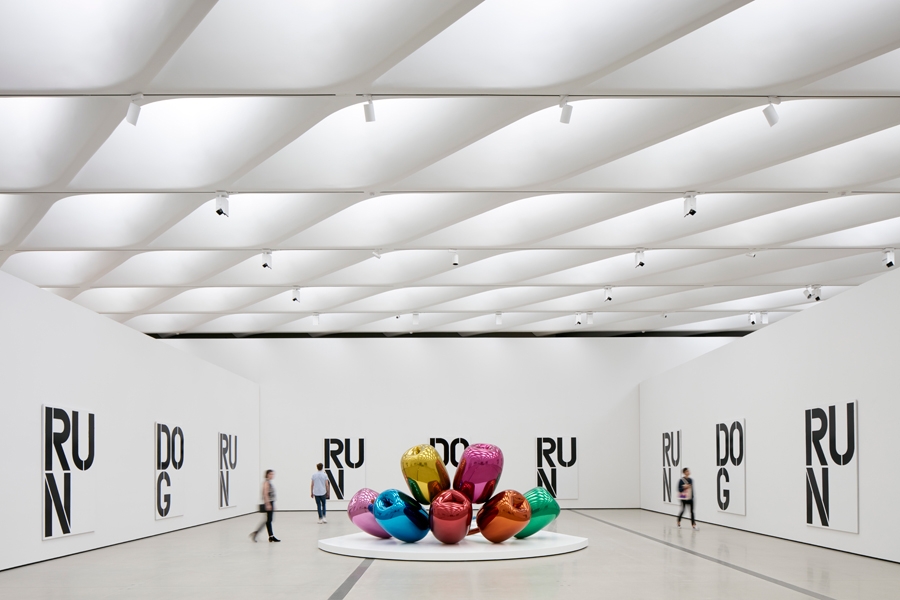‘There’s artwork by Murakami, Andy Warhol, Jean-Michael [sic] Basquiat, Roy Lichtenstein – basically, all of the T-shirt graphics at UNIQLO.’
– Kristen H. in a Yelp review, 17 October 2015
A bouquet of steel tulips. Through a concrete cave, a long escalator disgorges me at the petals of these giant, mirror-polished stainless-steel tulips. Unwilted and unwilting, the candy-coloured flowers will never die, a speculation on immortality and value. That’s always art’s gamble. As with grand architecture.
Standing on the third floor of Eli and Edythe Broad’s newest museum, in the heart of a cultural district the Broads helped invent in a sprawling metropolis that Eli, through his real-estate development company, helped build, the relationship between power and money, cities and art, feels a lot less clear than does the room reflected back at me in the mirror polish of Jeff Koons’s Tulips (1995–2004). Behind the giant flowers, The Broad has hung a series of untitled paintings by Christopher Wool from 1990 that say in giant blocky, black stencil letters: ‘Run Dog Run Run Dog Run Run Dog Run.’ I try not to take it personally.
In 2012, Eli named his memoir/success guide The Art of Being Unreasonable, combining the two aspects for which he’d like to be known: art and being unreasonable. Eli is a difficult and demanding philanthropist and his new museum feels like many of his other acts of generosity: welcome but somehow also tainted. One begins to question why he gets to dictate the terms. How could one family acquire so much money and what does all that money actually buy?
The $140-million-dollar museum houses $2 billion dollars worth of art collected by the Broads over the last four decades. Wandering over the polished concrete floors under the diffused light of cleverly designed skylights, you see room after room of large works, individual galleries mostly focused on single artists, or complementary works between two to three artists, much of it by familiar pop icons.
Mostly blue-chip, approved by markets and some version of consensus, the work that sticks out is the easiest to trash: Eli and Edythe really loved the artists of the 1980s in New York. I find it the only ripple of personality in an otherwise anonymous exhibition of international power. It’s easy to scoff at the neo-expressionists and hothouse figurative painters of those years, but that’s probably more fashion and over-speculation talking than anything else. For sure, some of those guys (mostly men, though one of Susan Rothenberg’s horses prances along the wall) were dicks and blowhards, but altogether they embodied boththe terrible inequalities and glassy possibilities of that time. There’s a certain glee in seeing those speculative objects, a plate-piece by Julian Schnabel or the suburban dread of a figurative painting by David Salle, that most well-educated museum curators often keep stored away.
And even amongst the blue-chips and consensus buys there are many works that sing, sometimes literally, as in Ragnar Kjartansson’s The Visitors (2012). Across nine channels of video a band passionately plays, separated by rooms and screens, a simple melancholic tune through a rambling old mansion, coming together in a procession across the fields and ending as a man silently walks through the house and turns off all the cameras one by one.
The neighbourhood that once occupied South Grand Ave was wiped away by the city 40 years ago, and The Broad displaced only a parking lot. Whatever the system that made an Eli Broad and his billions possible, today none of the dispossessed is going to defeat it. So many signs of wealth and power and being unreasonable abound in this chilly mausoleum, but still we have this museum filled with works you can love or hate and still see freely, without any admission costs, whenever you want. You can return to The Visitors as many times as you desire to catch a few minutes or the whole hour of this beautiful performance. You can ride that escalator up through the cavern six days a week and look at your reflection in those steel tulips and sooner or later figure out, better than I have, the tangled nature of beauty and power, immortality and art, the mixed blessings of power’s munificence.
This article was first published in the December 2015 issue of ArtReview.
